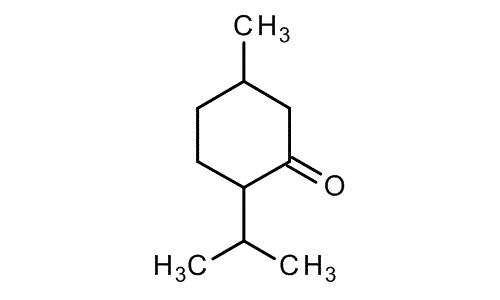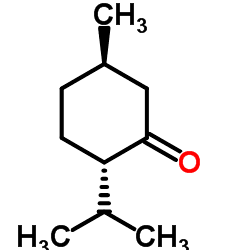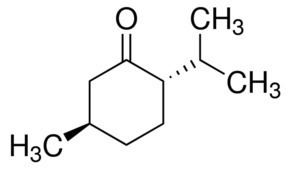Formula C10H18O Boiling point 207 °C | Molar mass 154.25 g/mol Density 895 kg/m³ | |
Menthone is a naturally occurring organic compound with a molecular formula C10H18O. l-Menthone (or (2S, 5R)-trans-2-isopropyl-5-methylcyclohexanone), shown at right, is the most abundant in nature of the four possible stereoisomers. Menthone is a monoterpene and a ketone. It is structurally related to menthol which has a secondary alcohol in place of the carbonyl.
Contents

Menthone is used in perfumery and cosmetics for its characteristic aromatic and minty odor.
Occurrence

Menthone is a constituent of the essential oils of pennyroyal, peppermint, Mentha arvensis, Pelargonium geraniums, and others. In most essential oils, it is a minor compound. This is the cause for the fact that it was first synthesized by oxidation of menthol in 1881 before it was found in essential oils in 1891.
Preparation

Menthone is cheaply available as a mixture of isomers; when enantiopure, it costs significantly more. In the laboratory, l-menthone may be prepared by oxidation of menthol with acidified dichromate.

If the chromic acid oxidation is performed with stoichiometric oxidant in the presence of diethyl ether as co-solvent, a method introduced by H.C. Brown, the epimerization of l-menthone to d-isomenthone is largely avoided. If menthone and isomenthone are equilibrated at room temperature, the isomenthone content will reach 29%. Pure l-menthone has an intensely minty clean aroma. By contrast, d-isomenthone has a "green" note, increasing levels of which are perceived to detract from the odor-quality of l-menthone.
Usage as pesticide
Menthone is a naturally occurring pesticide used in some products such as Ecosmart Roach Killer.
History
Menthone was first described by Moriya in 1881. It was then synthesized by heating menthol with chromic acid.

Menthone was crucial to one of the great mechanistic discoveries in organic chemistry. In 1889, Ernst Beckmann discovered that dissolving menthone in concentrated sulfuric acid gave a new ketonic material. Coincidentally, the product gave an equal but opposite optical rotation to the starting material. The tetrahedral carbon having been recognized for only 15 years at that time, Beckmann realized that this must result from an inversion of configuration at the asymmetric carbon atom next to the carbonyl group (at that time thought to be carbon attached to the methyl, rather than the isopropyl group), and he postulated this as happening through the intermediacy of an enol tautomer in which the asymmetric carbon atom was of trigonal (planar) rather than of tetrahedral geometry. This was an early example of the inference of an (almost) undetectable intermediate in a reaction mechanism accounting for the outcome of the reaction.


